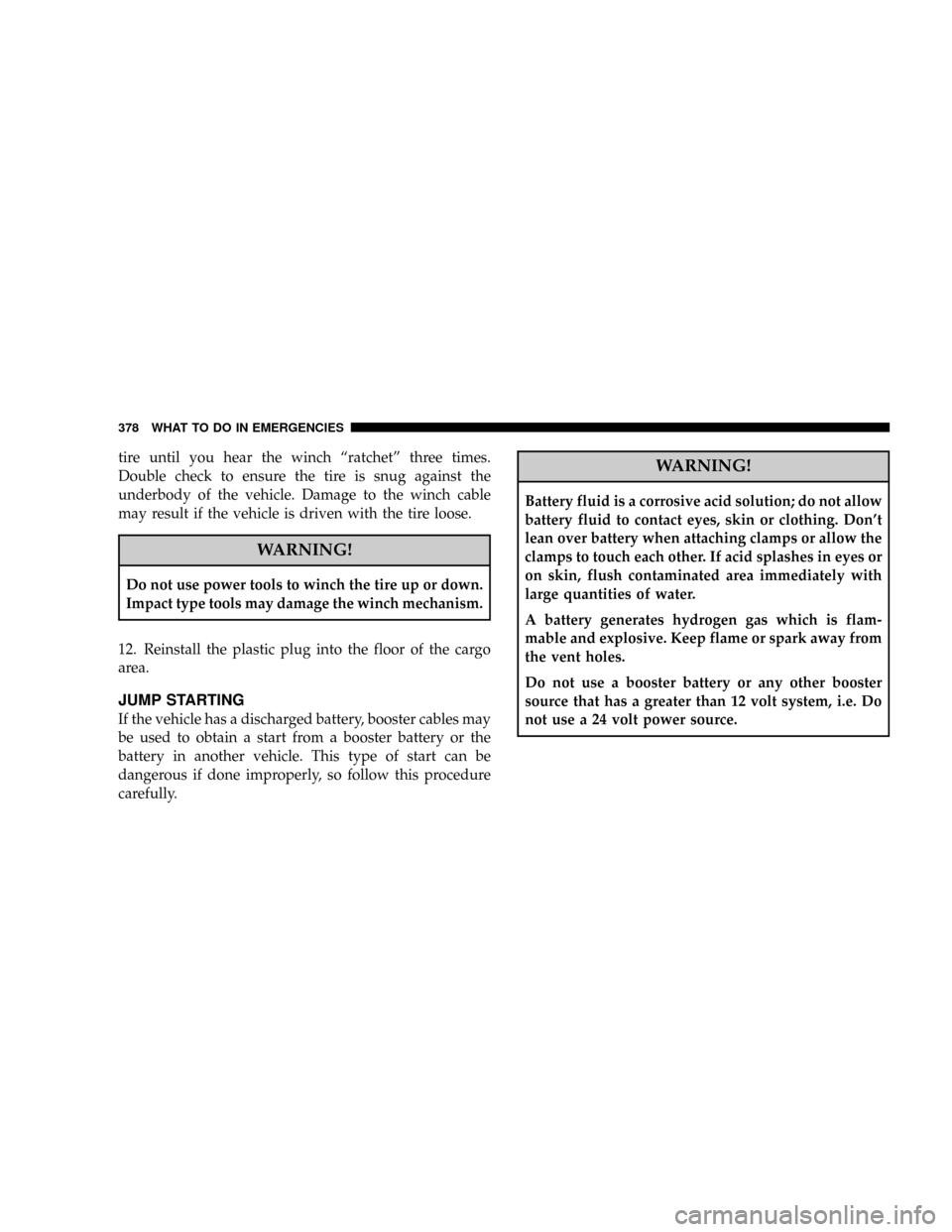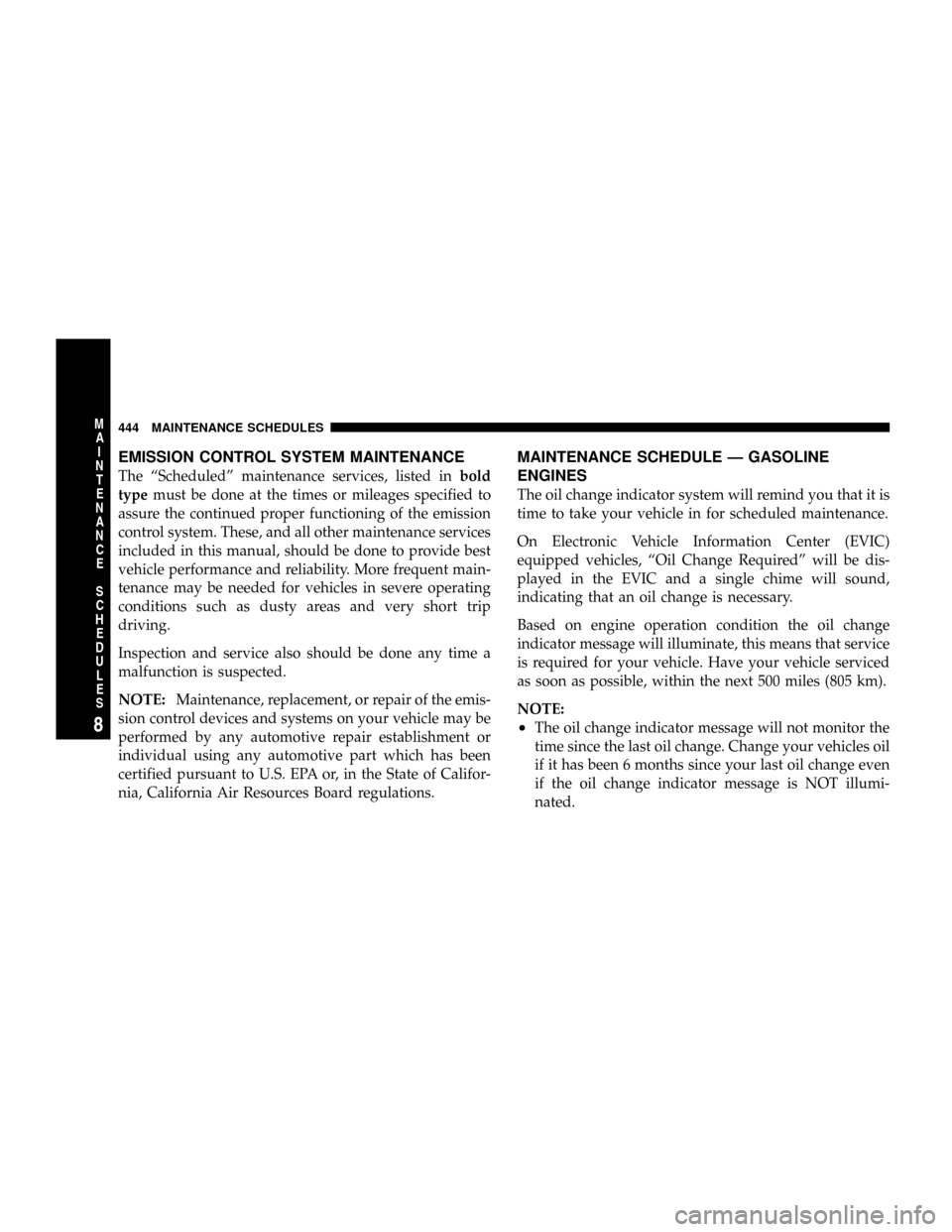2008 JEEP GRAND CHEROKEE gas type
[x] Cancel search: gas typePage 181 of 490

UNDERSTANDING YOUR INSTRUMENT PANEL
CONTENTS
mInstrument Panel And Controls.............185
mInstrument Cluster......................186
NGasoline Engine......................186
NDiesel Engine........................187
mInstrument Cluster Description.............188
mElectronic Vehicle Information Center (EVIC) . . . 196
NElectronic Vehicle Information Center (EVIC)
Displays............................198
NEngine Oil Change Indicator System........201NTrip Functions.......................201
NCompass Display.....................204
NPersonal Settings (Customer Programmable
Features)...........................206
NSystem Status........................211
mRadio General Information................212
NRadio Broadcast Signals.................212
NTwo Types Of Signals..................212
NElectrical Disturbances..................2124
Page 378 of 490

tire until you hear the winch ªratchetº three times.
Double check to ensure the tire is snug against the
underbody of the vehicle. Damage to the winch cable
may result if the vehicle is driven with the tire loose.
WARNING!
Do not use power tools to winch the tire up or down.
Impact type tools may damage the winch mechanism.
12. Reinstall the plastic plug into the floor of the cargo
area.
JUMP STARTING
If the vehicle has a discharged battery, booster cables may
be used to obtain a start from a booster battery or the
battery in another vehicle. This type of start can be
dangerous if done improperly, so follow this procedure
carefully.
WARNING!
Battery fluid is a corrosive acid solution; do not allow
battery fluid to contact eyes, skin or clothing. Don't
lean over battery when attaching clamps or allow the
clamps to touch each other. If acid splashes in eyes or
on skin, flush contaminated area immediately with
large quantities of water.
A battery generates hydrogen gas which is flam-
mable and explosive. Keep flame or spark away from
the vent holes.
Do not use a booster battery or any other booster
source that has a greater than 12 volt system, i.e. Do
not use a 24 volt power source.
378 WHAT TO DO IN EMERGENCIES
Page 395 of 490

Change Engine Oil
Refer to the Maintenance Schedule for recommended
engine oil change intervals.
Engine Oil Selection Ð Gasoline Engines
For best performance and maximum protection for all
engines under all types of operating conditions, the
manufacturer recommends engine oils that are API Cer-
tified and meet the requirements of DaimlerChrysler
Material Standard MS-6395.
American Petroleum Institute (API) Engine Oil
Identification Symbol
This symbol means that the oil has
been certified by the American
Petroleum Institute (API). The
manufacturer only recommends
API Certified engine oils.
Engine Oil Selection - Diesel Engines
For best performance and maximum protection for all
engines under all types of operating conditions, the
manufacturer recommends engine oils that are API Cer-
tified and meet the requirements of DaimlerChrysler
Material Standard MS-11106, or Mercedes Benz MB
229.31 or MB 229.51 and ACEA C3 qualified engine oils
MAINTAINING YOUR VEHICLE 395
7
Page 412 of 490

²Make sure that the radiator and coolant recovery
bottle hoses are not kinked or obstructed.
²Keep the front of the radiator clean. If your vehicle is
equipped with air conditioning, keep the front of the
condenser clean, also.
²Do not change the thermostat for summer or winter
operation. If replacement is ever necessary, install
ONLY the correct type thermostat. Other designs may
result in unsatisfactory cooling performance, poor gas
mileage, and increased emissions.
Hoses and Vacuum/Vapor Harnesses
Inspect surfaces of hoses and nylon tubing for evidence
of heat and mechanical damage. Hard or soft spots,
brittle rubber, cracking, tears, cuts, abrasions, and exces-
sive swelling indicate deterioration of the rubber.Pay particular attention to the hoses nearest to high heat
sources such as the exhaust manifold. Inspect hose rout-
ing to be sure hoses do not touch any heat source or
moving component that may cause heat damage or
mechanical wear.
Insure nylon tubing in these areas has not melted or
collapsed. Inspect all hose connections such as clamps
and couplings to make sure they are secure and no leaks
are present. Components should be replaced immedi-
ately if there is any evidence of degradation that could
cause failure.Fuel System Connections
Electronic Fuel Injection high pressure fuel systems are
designed with tubes and special connects, connections
and clamps which have unique material characteristics to
provide adequate sealing and resist attack by deterio-
rated gasoline.
412 MAINTAINING YOUR VEHICLE
Page 444 of 490

EMISSION CONTROL SYSTEM MAINTENANCE
The ªScheduledº maintenance services, listed inbold
typemust be done at the times or mileages specified to
assure the continued proper functioning of the emission
control system. These, and all other maintenance services
included in this manual, should be done to provide best
vehicle performance and reliability. More frequent main-
tenance may be needed for vehicles in severe operating
conditions such as dusty areas and very short trip
driving.
Inspection and service also should be done any time a
malfunction is suspected.
NOTE:Maintenance, replacement, or repair of the emis-
sion control devices and systems on your vehicle may be
performed by any automotive repair establishment or
individual using any automotive part which has been
certified pursuant to U.S. EPA or, in the State of Califor-
nia, California Air Resources Board regulations.
MAINTENANCE SCHEDULE Ð GASOLINE
ENGINES
The oil change indicator system will remind you that it is
time to take your vehicle in for scheduled maintenance.
On Electronic Vehicle Information Center (EVIC)
equipped vehicles, ªOil Change Requiredº will be dis-
played in the EVIC and a single chime will sound,
indicating that an oil change is necessary.
Based on engine operation condition the oil change
indicator message will illuminate, this means that service
is required for your vehicle. Have your vehicle serviced
as soon as possible, within the next 500 miles (805 km).
NOTE:
²The oil change indicator message will not monitor the
time since the last oil change. Change your vehicles oil
if it has been 6 months since your last oil change even
if the oil change indicator message is NOT illumi-
nated.
444 MAINTENANCE SCHEDULES
8
M
A
I
N
T
E
N
A
N
C
E
S
C
H
E
D
U
L
E
S
Page 490 of 490

INTRODUCTION INTRODUCTION ROLLOVER WARNING HOW TO USE THIS MANUAL WARNINGS AND CAUTIONS VEHICLE IDENTIFICATION NUMBER VEHICLE MODIFICATIONS/ALTERATIONS THINGS TO KNOW BEFORE STARTING YOUR VEHICLE A WORD
ABOUT YOUR KEYS Wireless Ignition Node (WIN)Fob with Integrated Key (FOBIK)Ignition Key RemovalKey-In-Ignition ReminderSENTRY KEY Replacement KeysCustomer Key (Fob) ProgrammingGeneral InformationSECURITY ALARM SYSTEM - IF EQUIPPED To Set
the AlarmTo Disarm the SystemILLUMINATED ENTRY REMOTE KEYLESS ENTRY To Unlock the DoorsTo Lock the DoorsTo Release the Liftgate Flipper GlassUsing The Panic AlarmProgramming Additional TransmittersTransmitter Battery ServiceGeneral Information
REMOTE STARTING SYSTEM - IF EQUIPPED DOOR LOCKS Manual Door LocksPower Door LocksChild Protection Door LockWINDOWS Power WindowsWind BuffetingLIFTGATE Liftgate Flipper GlassOCCUPANT RESTRAINTS Lap/Shoulder BeltsLap/Shoulder Belt
Operating InstructionsAdjustable Upper Shoulder Belt AnchorageAutomatic Locking Mode - If EquippedEnergy Management FeatureSeat Belt PretensionersEnhanced Seat Belt Use Reminder System (BeltAlert)Seat Belts and Pregnant WomenSeat Belt ExtenderDriver And
Front Passenger Supplemental Restraint Systems (SRS) Child RestraintENGINE BREAK-IN RECOMMENDATIONS SAFETY TIPS Exhaust GasSafety Checks You Should Make Inside The VehicleSafety Checks You Should Make Outside The VehicleUNDERSTANDING
THE FEATURES OF YOUR VEHICLE MIRRORS Inside Day/Night MirrorAutomatic Dimming Mirror - If EquippedOutside MirrorsExterior Mirrors Folding FeatureDrivers and Front Passenger Outside Automatic Dimming Mirror - If EquippedPower Remote Control Mirrors
- If EquippedHeated Remote Control Mirrors - If EquippedLighted Vanity Mirrors - If EquippedHANDS-FREE COMMUNICATION (UConnect) - IF EQUIPPED OperationPhone Call FeaturesUConnect System FeaturesAdvanced Phone ConnectivityThings You Should Know
About Your UConnect SystemGeneral InformationSEATS Front Manual Seat AdjustmentFront Seat Adjustment - ReclineManual Lumbar Support Adjustment8 - Way Drivers Power Seat4 - Way Passengers Power Seat - If EquippedHead RestraintsFront Heated Seats-If
EquippedRear Heated Seats - If Equipped60/40 Split Rear SeatDRIVER MEMORY SEAT - IF EQUIPPED Setting Memory Positions and Linking Remote Keyless Entry Transmitter to MemoryMemory Position RecallTo Disable A Transmitter Linked to MemoryEasy Entry/Exit
SeatTO OPEN AND CLOSE THE HOOD LIGHTS Multi-Function Control LeverBattery Saver Feature-Exterior/Interior LightsHeadlights and Parking LightsAutomatic Headlight System - If EquippedSmartBeams - If EquippedInstrument Panel and Interior LightsDaytime Running
Lights - If EquippedAutomatic Headlight Leveling - HID Headlights OnlyLights-On ReminderFog Lights - If EquippedTurn SignalsHigh Beam SwitchPassing LightHeadlight Time DelayInterior LightsFront Map/Reading LightsWINDSHIELD WIPERS AND WASHERS MistSpeed
Sensitive Intermittent Wiper SystemRain Sensing Wipers-If EquippedTILT/TELESCOPING STEERING COLUMN ADJUSTABLE PEDALS - IF EQUIPPED ELECTRONICSPEED CONTROL - IF EQUIPPED Electronic Speed Control OperationTo ActivateTo Set At A Desired
SpeedTo DeactivateTo Resume SpeedTo Vary The Speed SettingTo Accelerate For PassingELECTRONIC BRAKE CONTROL SYSTEM ABS (Anti-Lock Brake System)TCS (Traction Control System)BAS (Brake Assist System)ERM (Electronic Roll Mitigation)ESP (Electronic
Stability Program)TSC (Trailer Sway Control)HSA (Hill Start Assist) (4WD Models with NV245 Two-Speed Transfer Case Only)HDC (Hill Descent Control) (4WD Models with NV245 Two-Speed Transfer Case Only)ESP/BAS Warning Lamp and ESP/TCS Indicator LightREAR
PARK ASSIST SYSTEM- IF EQUIPPED Rear Park Assist SensorsRear Park Assist Warning DisplayEnable/Disable the Rear Park Assist SystemService the RearPark Assist SystemCleaning the Rear Park Assist SystemREAR CAMERA - IF EQUIPPED Turning the Rear
Camera OnTurning the Rear Camera OffOVERHEAD CONSOLE Courtesy/Reading LightsSunglasses StorageGARAGE DOOR OPENER - IF EQUIPPED Programming HomeLinkGate Operator/Canadian ProgrammingUsing HomeLinkReprogramming a Single HomeLink
ButtonSecurityTroubleshooting TipsGeneral InformationPOWER SUNROOF - IF EQUIPPED Opening Sunroof - ExpressClosing Sunroof - ExpressPinch Protect FeaturePinch Protect OverrideVenting Sunroof - ExpressSunshade OperationWind BuffetingSunroof Maintenance
Ignition Off OperationSunroof Fully ClosedPOWER OUTLETS Front Power OutletRear Power Outlet - If EquippedPOWER INVERTER - IF EQUIPPED CUP HOLDERS CARGO AREA FEATURES Cargo LightRear Storage CompartmentRetractable Cargo Area Cover - If
EquippedCargo Tie-Down HooksCargo Load FloorREAR WINDOW FEATURES Rear Window Wiper/Washer - If EquippedRear Window Defroster - If EquippedROOF LUGGAGE RACK - IF EQUIPPED UNDERSTANDING YOUR INSTRUMENT PANEL INSTRUMENT PANEL
AND CONTROLS INSTRUMENT CLUSTER Gasoline Engine Diesel Engine INSTRUMENT CLUSTER DESCRIPTION ELECTRONIC VEHICLE INFORMATION CENTER (EVIC) Electronic Vehicle Information Center (EVIC) DisplaysEngine Oil Change Indicator System
Trip FunctionsCompass DisplayPersonal Settings (Customer Programmable Features)System StatusRADIO GENERAL INFORMATION Radio Broadcast SignalsTwo Types of SignalsElectrical DisturbancesAM ReceptionFM ReceptionSALES CODE REQ - AM/FM STEREO
RADIO AND 6-DISC CD/DVD CHANGER (MP3/WMA AUX JACK) Operating Instructions - Radio ModeOperation Instructions - (DISC MODE for CD and MP3/WMA Audio Play, DVD-VIDEO)Notes On Playing MP3/WMA FilesLIST Button (DISC Mode for MP3/WMA Play)
INFO Button (DISC Mode for MP3/WMA Play)SALES CODE RES - AM/FM STEREO RADIO WITH CD PLAYER (MP3 AUX JACK) Operating Instructions - Radio ModeOperationInstructions - CD MODE for CD and MP3 Audio PlayNotes On Playing MP3 FilesLIST Button
(CD Mode for MP3 Play)INFO Button (CD Mode for MP3 Play)SALES CODE REN - MULTIMEDIA SYSTEM - IF EQUIPPED Operating Instructions - Satellite Radio (If Equipped)Operating Instructions - Hands-Free Communication (UConnect) (If Equipped)Clock Setting
ProcedureSALES CODE RER - AM/FM/CD/DVD RADIO WITH NAVIGATION SYSTEM - IF EQUIPPED Operating Instructions - Satellite RadioClock Setting ProcedureUNIVERSAL CONSUMER INTERFACE (UCI) - IF EQUIPPED Connecting the iPodControlling the iPod
using Radio ButtonsPlay ModeList or Browse ModeSATELLITE RADIO (RSC) - IF EQUIPPED (REQ AND RES RADIOS ONLY) System ActivationElectronic Serial Number/Sirius Identification Number (ENS/SID)Selecting Satellite ModeSatellite AntennaReception Quality
Operating Instructions - Satellite ModeOperating Instructions - Hands Free Phone (If Equipped)Operating Instructions - Video Entertainment System (VES) (If Equipped)VIDEO ENTERTAINMENT SYSTEM (SALES CODE XRV) - IF EQUIPPED REMOTE SOUND SYSTEM
CONTROLS - IF EQUIPPED Radio OperationCD PlayerCD/DVD DISC MAINTENANCE RADIO OPERATION AND CELLULAR PHONES CLIMATE CONTROLS Manual Air Conditioning and Heating System - If EquippedAutomatic Temperature Control - If EquippedOperating
TipsOperating Tips Chart STARTING AND OPERATING STARTING PROCEDURE Normal Starting - Gasoline EnginesExtremely Cold Weather (below -20 degrees F or -29 degrees C)If Engine Fails to StartAfter StartingNormal Starting - Diesel EnginesENGINE BLOCK
HEATER - IF EQUIPPED AUTOMATIC TRANSMISSION Shift Lock Manual Override - If EquippedBrake/Transmission Interlock System5-Speed Automatic TransmissionGear RangesRocking the VehicleFOUR-WHEEL DRIVE OPERATION Quadra-Trac I Operating
Instructions/Precautions - If EquippedQuadra-Trac II Operating Instructions/Precautions - If EquippedShift PositionsShifting ProceduresQuadra-Drive II System - If EquippedON-ROAD DRIVING TIPS OFF-ROAD DRIVING TIPS When To Use 4WD LOW Range - If Equipped
Driving Through WaterDriving In Snow, Mud and SandHill ClimbingTraction DownhillAfter Driving Off-RoadPARKING BRAKE ANTI-LOCK BRAKE SYSTEM POWER STEERING MULTI DISPLACEMENT SYSTEM (MDS) - 5.7L Engine Only TIRE SAFETY INFORMATION
Tire Markings Tire Identification Number (TIN)Tire Loading and Tire PressureTIRES - GENERAL INFORMATION Tire PressureTire Inflation PressuresTire Pressures for High Speed OperationRadial-Ply TiresTire SpinningTread Wear IndicatorsLife of TireReplacement Tires
Alignment and BalanceTIRE CHAINS TIRE ROTATION RECOMMENDATIONS TIRE PRESSURE MONITOR SYSTEM (TPMS) Base System - If EquippedPremium System - If EquippedGeneral InformationFUEL REQUIREMENTS 3.7/4.7L Engines (If Equipped)5.7L Engines
(If Equipped)Reformulated GasolineGasoline/Oxygenate BlendsMMT In GasolineMaterials Added To FuelFuel System CautionsCarbon Monoxide WarningsFLEXIBLE FUEL (4.7L ENGINE ONLY) - IF EQUIPPED E-85 General InformationETHANOL FUEL (E-85)Fuel
RequirementsSelection Of Engine Oil For Flexible Fuel Vehicles (E-85) and Gasoline VehiclesStartingCruising RangeReplacement PartsFUEL REQUIREMENTS (DIESEL ENGINES) ADDING FUEL Fuel Filler Cap (Gas Cap)VEHICLE LOADING Certification LabelTRAILER
TOWING Common Towing DefinitionsTrailer Hitch ClassificationTrailer Towing Weights (Maximum Trailer Weight Ratings)Trailer and Tongue WeightTowing RequirementsTowing TipsRECREATIONAL TOWING (BEHIND MOTORHOME, ETC.) Towing - 2WD ModelsTowing
- Quadra-Trac I (Single-Speed Transfer Case) 4WD ModelsTowing - Quadra-Trac II /Quadra-Drive II 4WD ModelsSNOW PLOW WHAT TO DO IN EMERGENCIES HAZARDWARNING FLASHERS IF YOUR ENGINE OVERHEATS JACKING AND TIRE CHANGING Jack
LocationSpare Tire StowageSpare Tire RemovalPreparations For JackingJacking InstructionsJUMP STARTING EMERGENCY TOW HOOKS - IF EQUIPPED TOWINGA DISABLED VEHICLE 2WD Models Only4WD Models OnlyMAINTAINING YOUR VEHICLE ENGINE
COMPARTMENT - 3.7L ENGINE COMPARTMENT - 4.7L ENGINE COMPARTMENT - 5.7L ENGINE COMPARTMENT - 3.0L DIESEL ONBOARD DIAGNOSTIC SYSTEM - OBD II Loose Fuel Filler Cap MessageEMISSIONS INSPECTION AND MAINTENANCE PROGRAMS
REPLACEMENT PARTS DEALER SERVICE MAINTENANCE PROCEDURES Engine OilDrive Belts - Check Condition and TensionSpark PlugsSpark Plug WiresEngine AirCleaner FilterCatalytic ConverterCrankcase Emission Control SystemMaintenance-Free BatteryAir
Conditioner MaintenancePower Steering Fluid CheckBody LubricationWindshield Wiper BladesWindshield Washers - Front and RearExhaust SystemCooling SystemHoses and Vacuum/Vapor HarnessesFuel System ConnectionsBrake SystemFront/Rear Axle FluidTransfer
CaseAutomatic TransmissionMaintenance After Off-Road DrivingAppearance Care And Protection From CorrosionFUSE PANEL Interior FusesUnderhoodFuses (Power Distribution Center) Underhood Fuses (Integrated Power Module) VEHICLE STORAGE REPLACEMENT
BULBS BULB REPLACEMENT High Intensity Discharge Headlights (HID) - If EquippedHead LightFront Turn SignalFront Fog LightRear Tail, Stop, Turn Signal, and Back-Up LightsCenter High Mounted Stop Light (CHMSL)FLUIDS AND CAPACITIES FLUIDS, LUBRICANTS,
AND GENUINE PARTS EngineChassisMAINTENANCE SCHEDULES EMISSION CONTROL SYSTEM MAINTENANCE MAINTENANCE SCHEDULE - GASOLINE ENGINES Required Maintenance IntervalsMAINTENANCE SCHEDULES - DIESEL ENGINE Schedule B
- Diesel EngineSchedule A - Diesel EngineIF YOU NEED CONSUMER ASSISTANCE SUGGESTIONS FOR OBTAINING SERVICE FOR YOUR VEHICLE Prepare For The AppointmentPrepare A ListBe Reasonable With RequestsIF YOU NEED ASSISTANCE WARRANTY
INFORMATION (U.S. Vehicles Only) MOPAR PARTS REPORTING SAFETY DEFECTS In CanadaPUBLICATION ORDER FORMS DEPARTMENT OF TRANSPORTATION UNIFORM TIREQUALITY GRADES TreadwearTraction GradesTemperature GradesINDEX